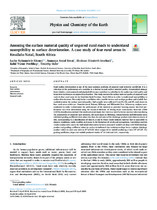| dc.contributor.author | Nkomo, Lucky S'phumelele | |
| dc.contributor.author | Desai, Sumaiya Amod | |
| dc.contributor.author | Dube, Timothy | |
| dc.date.accessioned | 2021-06-22T09:36:40Z | |
| dc.date.available | 2021-06-22T09:36:40Z | |
| dc.date.issued | 2019 | |
| dc.identifier.citation | Nkomo ,L. S. et al.(2019). Assessing the surface material quality of unpaved rural roads to understand susceptibility to surface deterioration. A case study of four rural areas in KwaZulu-Natal, South Africa. Physics and Chemistry of the Earth, 112(March), 3–11. https://doi.org/10.1016/j.pce.2019.04.005 | en_US |
| dc.identifier.issn | 1474-7065 | |
| dc.identifier.uri | https://doi.org/10.1016/j.pce.2019.04.005 | |
| dc.identifier.uri | http://hdl.handle.net/10566/6330 | |
| dc.description.abstract | Road surface deterioration is one of the most common problems of unpaved road networks worldwide. It is areduction in the performance of a road due to a decline in road surface material quality. Accumulated damagefrom vehicles, environmental and physical effects may contribute to a decline in the surface material quality andhence deterioration on an unpaved road surface. This study assesses the surface material quality of unpaved ruralroads in four rural areas in the KwaZulu-Natal Province, South Africa in order to understand susceptibility tosurface deterioration. The study further establishes other possible factors such as slope gradient and rainfall, thatcould determine the surface material quality. Soil samples were collected from R3, R4, and R5 road classes infour rural areas which are: Emazabekweni, Dukuza, Mkhunya and Mhlwazini Area. Laboratory analyses wereconducted in order to determine the performance of the material as potential wearing course. Material per-formance was then determined using the Standard Methods of Testing Road Construction Materials (TMH1:1976) classification method. The results obtained imply that there is a need for better material selection duringthe construction of unpaved road networks. All road classes in Mkhunya, Emazabekweni and Mhlwazini areasexhibited grading coefficient (Gc) values less than 16 and some of the shrinkage product (Sp) values in excess of365, corresponding to a classification of Class D, A and B. These results indicate material that is susceptible toslippery conditions, easily erodible and prone to the formation of ravels and corrugations. Correlation analysisresults conducted to assess the individual relationship between measured rainfall and slope with field shrinkageproduct and grading coefficient values in each area indicated that variation in slope better explains shrinkageproduct values in each area with an R2of 0.62 when compared to rainfall producing a lower R2of 0.57. Forgrading coefficient, slope and rainfall produced similar R2of 0.65 and 0.67, respectively. | en_US |
| dc.language.iso | en | en_US |
| dc.publisher | Elsevier | en_US |
| dc.subject | Road surface | en_US |
| dc.subject | Deterloration | en_US |
| dc.subject | Materlal selection | en_US |
| dc.subject | Unpaved roads | en_US |
| dc.subject | KwaZulu-Nata | en_US |
| dc.title | Assessing the surface material quality of unpaved rural roads to understand susceptibility to surface deterioration. A case study of four rural areas in KwaZulu-Natal, South Africa | en_US |
| dc.type | Article | en_US |

